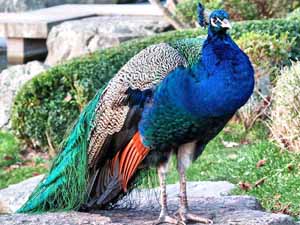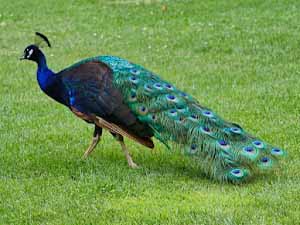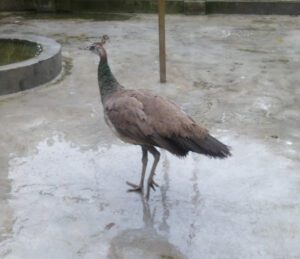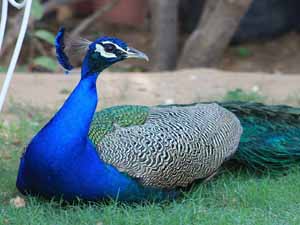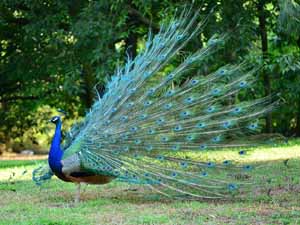The Indian Blue Peafowl (Pavo cristatus), also known as the Common Peafowl, is a stunning bird native to the Indian subcontinent. It is a very common breed used in commercial peacock farming business. It is one of the most well-known and recognizable birds in the world due to its vibrant and iridescent blue and green plumage.
The male peafowl is known for its long and extravagant tail feathers, which can be as long as six feet and are covered in distinctive eye-shaped markings. Indian Blue Peafowl are social birds that thrive in groups, and they can often be found roaming in pairs or small flocks in their native habitats. They are also highly adaptable and can be found in a variety of environments, including forests, grasslands, and agricultural areas.
While Indian Blue Peafowl are not considered endangered, their populations have declined due to habitat loss and hunting. Conservation efforts are underway to protect these beautiful birds and their habitats. However, read full information of this beautiful peafowl breed below.
Origin And History Of Indian Blue Peafowl
The exact origin of the Indian Blue Peafowl is not known, but they are believed to have originated in India over 5,000 years ago. Indian Blue Peafowl have played an important role in Indian culture and mythology for thousands of years. They are often depicted in Indian art and literature and are considered a symbol of beauty, grace, and prosperity. In Hindu mythology, the peacock is associated with Lord Kartikeya, the god of war, and is considered a sacred bird.
Characteristics
The Indian Blue Peafowl is a stunningly beautiful bird with unique and distinctive features that make it one of the most recognizable birds in the world. The male peafowl, also known as the peacock, has long, iridescent feathers that are predominantly blue with green and bronze highlights. The most distinctive feature of the male peafowl is its long, flowing tail feathers that can reach up to six feet in length. These feathers are adorned with iridescent “eyes” that shimmer in the light. When the male peafowl spreads its tail feathers, it creates a dazzling display that is truly breathtaking to behold.
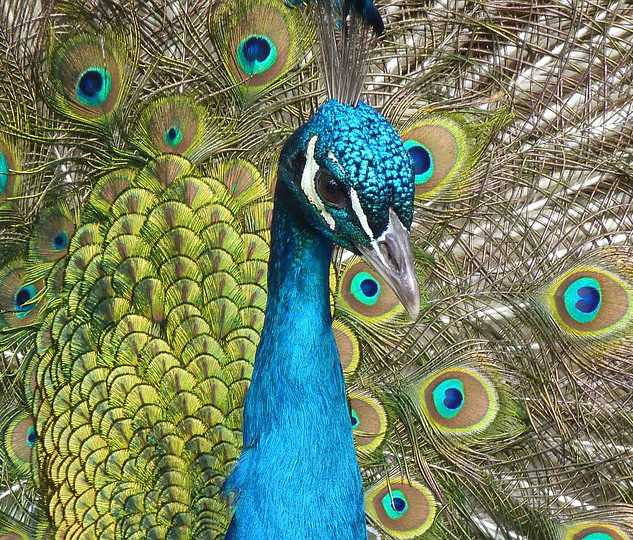
In contrast, the female peafowl, also known as the peahen, has a more muted appearance. Her feathers are a warm, reddish-brown color with a greenish head. While she does not have the long, flowing tail feathers of the male, she is still a striking bird in her own right, with a graceful and elegant appearance.
Both male and female Indian Blue Peafowl have a distinctive crest of feathers on their heads, and their faces are adorned with bright blue skin and a small black patch of feathers that resemble a tear drop. They have long, slender necks and legs, and their bodies are sleek and streamlined, making them agile and graceful in their movements.
The Indian Blue Peafowl is a large bird, with males typically weighing between 9 to 13 pounds and measuring up to 5 feet in length. Females are slightly smaller, weighing between 5 to 9 pounds and measuring up to 3.5 feet in length.
Housing
Providing a spacious and secure housing setup is essential for the health and well-being of Indian Blue Peafowl. When it comes to housing Indian Blue Peafowl, it is important to provide them with ample space to move around and engage in natural behaviors. A large aviary or an enclosed outdoor area is ideal for housing them. The minimum recommended size for an aviary for a pair of peafowl is 20 feet by 20 feet, with a height of at least 8 feet. It is important to ensure that the enclosure is secure and protected from predators.

Feeding
It is very important to provide these birds with a balanced and nutritious diet that meets their nutritional needs. In the wild, Indian Blue Peafowl feed on a variety of foods, including insects, seeds, fruits, and small animals. In captivity, they require a diet that is high in protein, vitamins, and minerals to maintain their health and vitality. A balanced diet for Indian Blue Peafowl should consist of a mix of commercial feed, fresh fruits and vegetables, and protein sources such as insects, mealworms, and earthworms. It is important to provide the birds with a varied diet to ensure they receive all the necessary nutrients.
Breeding
The breeding season for Indian Blue Peafowl typically begins in early spring and lasts through the summer months. During this time, male peafowl, or peacocks, display their colorful and intricate plumage to attract potential mates. To successfully breed Indian Blue Peafowl, it is important to ensure that the birds are healthy and have access to adequate food, water, and shelter. Peafowl require a spacious and secure enclosure that allows them to move around freely and engage in their natural behaviors.
Once the breeding season begins, it is important to separate male and female peafowl to prevent aggressive behavior and ensure successful breeding. Male peafowl can become territorial and may harm females if they are not separated. The ideal ratio for breeding Indian Blue Peafowl is one male to two or three females. This allows for natural mating behavior and reduces the risk of injury to the females.
During the breeding season, it is important to monitor the birds’ behavior and ensure that the females are laying eggs. Indian Blue Peafowl typically lay eggs in shallow nests on the ground, so it is important to provide a suitable nesting area that is protected from predators.
Caring
Caring for Indian Blue Peafowl involves providing adequate shelter, feeding them a balanced diet, monitoring their health, and ensuring their social needs are met.
Uses
Indian Blue Peafowl have a wide range of uses, from their ornamental value to their pest control abilities and cultural significance. They are also a source of meat, eggs, feathers, and leather.

